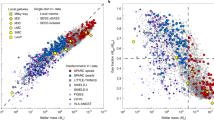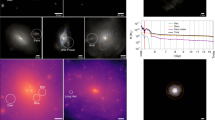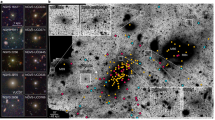Abstract
The known galaxies most dominated by dark matter (Draco, Ursa Minor and Andromeda IX) are satellites of the Milky Way and the Andromeda galaxies1,2,3,4. They are members of a class of faint galaxies, devoid of gas, known as dwarf spheroidals3,4,5, and have by far the highest ratio of dark to luminous matter3,6. None of the models proposed to unravel their origin7,8,9,10 can simultaneously explain their exceptional dark matter content and their proximity to a much larger galaxy. Here we report simulations showing that the progenitors of these galaxies were probably gas-dominated dwarf galaxies that became satellites of a larger galaxy earlier than the other dwarf spheroidals. We find that a combination of tidal shocks and ram pressure swept away the entire gas content of such progenitors about ten billion years ago because heating by the cosmic ultraviolet background kept the gas loosely bound: a tiny stellar component embedded in a relatively massive dark halo survived until today. All luminous galaxies should be surrounded by a few extremely dark-matter-dominated dwarf spheroidal satellites, and these should have the shortest orbital periods among dwarf spheroidals because they were accreted early.
This is a preview of subscription content, access via your institution
Access options
Subscribe to this journal
Receive 51 print issues and online access
$199.00 per year
only $3.90 per issue
Buy this article
- Purchase on Springer Link
- Instant access to full article PDF
Prices may be subject to local taxes which are calculated during checkout


Similar content being viewed by others
References
Mateo, M. Dwarf galaxies of the local group. Annu. Rev. Astron. Astrophys. 36, 435–506 (1998)
Grebel, E. K. in The Stellar Content of Local Group Galaxies (eds Whitelock, P. & Cannon, R.) 17–38 (IAU Symposium 192, ASP, San Francisco, 1999)
Kleyna, J. T., Wilkinson, M. I., Evans, N. W., Gilmore, G. & Frayn, C. Dark matter in dwarf spheroidals—II. Observations and modeling of Draco. Mon. Not. R. Astron. Soc. 330, 778–791 (2002)
Chapman, S. et al. Keck DEIMOS kinematic study of Andromeda IX: Dark matter on the smallest galactic scales. Astrophys. J. 632, L87–L90 (2005)
Gallagher, J. S., Madsen, G. J., Reynolds, R. J., Grebel, E. K. & Smecker-Hane, T. A. A search for ionized gas in the Draco and Ursa Minor dwarf spheroidal galaxies. Astrophys. J. 588, 326–330 (2003)
Kazantzidis, S. et al. Density profiles of cold dark matter substructure: implications for the missing-satellites problem. Astrophys. J. 608, 663–679 (2004)
Lin, D. N. C. & Faber, S. M. Some implications of nonluminous matter in dwarf spheroidal galaxies. Astrophys. J. 266, L21–L25 (1983)
Dekel, A. & Silk, J. The origin of dwarf galaxies, cold dark matter, and biased galaxy formation. Astrophys. J. 303, 39–55 (1986)
Bullock, J., Kravtsov, A. & Weinberg, D. H. Reionization and the abundance of galactic satellites. Astrophys. J. 539, 517–521 (2000)
Mayer, L. et al. The metamorphosis of tidally stirred dwarf galaxies. Astrophys. J. 559, 754–784 (2001)
de Blok, W. J. G. & McGaugh, S. S. The dark and visible matter content of low surface brightness disc galaxies. Mon. Not. R. Astron. Soc. 290, 533–552 (1997)
Mayer, L. & Moore, B. The baryonic mass-velocity relation: clues to feedback processes during structure formation and the cosmic baryon inventory. Mon. Not. R. Astron. Soc. 354, 477–484 (2004)
Susa, H. & Umemura, M. Formation of dwarf galaxies during the cosmic reionization. Astrophys. J. 600, 1–16 (2004)
Mac Low, M. M. & Ferrara, A. Starburst-driven mass loss from dwarf galaxies: efficiency and metal ejection. Astrophys. J. 513, 142–155 (1999)
Einasto, J., Kaasik, A. & Saar, E. Dynamic evidence on massive coronas of galaxies. Nature 252, 111–113 (1974)
Marcolini, A., Brighenti, F. & D'Ercole, A. Three-dimensional simulations of the interstellar medium in dwarf galaxies—I. Ram pressure stripping. Mon. Not. R. Astron. Soc. 345, 1329–1339 (2003)
Mori, M. & Burkert, A. Gas stripping of dwarf galaxies in clusters of galaxies. Astrophys. J. 538, 559–568 (2000)
Kravtsov, A. V., Gnedin, O. Y. & Klypin, A. A. The tumultuous lives of galactic dwarfs and the missing satellites problem. Astrophys. J. 609, 482–497 (2004)
Diemand, J., Madau, P. & Moore, B. The distribution and kinematics of early high-sigma peaks in present-day haloes: implications for rare objects and old stellar populations. Mon. Not. R. Astron. Soc. 364, 367–383 (2005)
Governato, F. et al. The formation of a realistic disk galaxy in lambda-dominated cosmologies. Astrophys. J. 607, 688–696 (2004)
Verde, L., Oh, P. S. & Jimenez, R. The abundance of dark galaxies. Mon. Not. R. Astron. Soc. 336, 541–549 (2002)
Haardt, F. & Madau, P. Radiative transfer in a clumpy universe. II. The ultraviolet extragalactic background. Astrophys. J. 461, 20–37 (1996)
Gunn, J. E. & Gott, J. R. I. On the infall of matter into clusters of galaxies and some effects on their evolution. Astrophys. J. 176, 1–19 (1972)
Munoz, R. P. et al. Exploring halo substructure with giant stars: the velocity dispersion profiles of the Ursa Minor and Draco Dwarf spheroidal galaxies at large angular separations. Astrophys. J. 631, L137–L141 (2005)
Willman, B., Governato, F., Dalcanton, J. J., Reed, D. & Quinn, T. The observed and predicted spatial distribution of Milky Way satellites. Mon. Not. R. Astron. Soc. 353, 639–646 (2004)
Moore, B. et al. Dark matter substructure within galactic halos. Astrophys. J. 524, L19–L22 (1999)
Willman, B. et al. A new Milky Way dwarf galaxy in Ursa Major. Astrophys. J. 626, L85–L88 (2005)
Kleyna, J. T., Wilkinson, M. I., Evans, N. W. & Gilmore, G. Ursa Major:a missing low mass CDM halo? Astrophys. J. 630, L141–L144 (2005)
Walker, M. G. et al. Internal kinematics of the Fornax dwarf spheroidal galaxy. Astron. J. 131, 2114–2139 (2006)
Acknowledgements
We thank Y. Birinboim, A. Dekel, F. Governato, A. Kravtsov, G. Lake, C. Porciani, M. Valluri, B. Willman and A. Zentner, for discussions. We also thank S. Majewski and R. Munoz for sharing their data with us. L. Mayer and S. Kazantzidis are grateful to the Aspen Center for Physics, where some of this work was completed. All computations were performed on the Zbox supercomputer at the University of Zürich, on LeMieux at the Pittsburgh Supercomputing Center, and on the Gonzales cluster at ETH Zürich.
Author information
Authors and Affiliations
Corresponding authors
Ethics declarations
Competing interests
Reprints and permissions information is available at www.nature.com/reprints. The authors declare no competing financial interests.
Supplementary information
Supplementary Information
This file contains Supplementary Notes, Supplementary Figures 1-6 and additional references (PDF 278 kb)
Rights and permissions
About this article
Cite this article
Mayer, L., Kazantzidis, S., Mastropietro, C. et al. Early gas stripping as the origin of the darkest galaxies in the Universe. Nature 445, 738–740 (2007). https://doi.org/10.1038/nature05552
Received:
Accepted:
Issue Date:
DOI: https://doi.org/10.1038/nature05552
This article is cited by
-
Synchrotron emission from neutralino dark matter annihilation in dwarf spheroidal galaxies
Journal of Astrophysics and Astronomy (2022)
-
Resonant stripping as the origin of dwarf spheroidal galaxies
Nature (2009)
-
A common mass scale for satellite galaxies of the Milky Way
Nature (2008)
Comments
By submitting a comment you agree to abide by our Terms and Community Guidelines. If you find something abusive or that does not comply with our terms or guidelines please flag it as inappropriate.



